Social and economic development. Рубрика в журнале - Arctic and North

Статья научная
The article examines foreign experience in implementing regional financial policy in relation to the Arctic territories. It assesses the experience of such sub-arctic countries as Canada, Finland, Denmark, Norway, Sweden, and the USA. The paper identifies two groups of financial instruments of territorial development: within the framework of general regional policy (instruments of fiscal capacity equalization, taxation instruments, instruments to increase investment attractiveness) and within the framework of special policy for the development of Arctic territories (program-targeted instruments, special development funds, direct allocation of funds for current expenses and development). It is concluded that the Arctic countries apply different approaches and tools to the development of the regions located in the Arctic zone, the choice of which is determined by the type of state structure, the degree of financial independence of the regions in the sphere of financial regulation, the level of development of the northernmost subjects compared to the rest of the country. In the conditions of Russia, it is possible to use the best foreign experience in the sphere of financial regulation of development of the regions located in the Arctic zone. In particular, it is possible to use the experience of applying program-targeted development tools, the formation of special development funds, which are based on revenues from the use of natural resources of the Arctic, as well as the experience of creating favourable conditions to attract investors for the implementation of economically attractive projects.
Бесплатно

Статья научная
The article examines the issues of financing the development of the Russian Arctic territories and the participation of banking structures in this process. A set of strategic documents for the development of the Arctic zone of the Russian Federation is considered, the dynamics of approved amounts of funding for Arctic development programs are analyzed, and the structure of sources of financing for investment in fixed assets in regions whose territory belongs to the Arctic zone of the Russian Federation is studied. It is concluded that banks are not sufficiently involved in investment activities in most of the Arctic regions (except the Yamal-Nenets Autonomous district, where the active role of banking institutions is due to participation in the financing of large gas and oil production projects in the Northern part of the region), and in recent years, foreign banking structures decline investment activity. The article describes the prospects of participation of the largest Russian banking structures in implementing large-scale projects in the Arctic, such as VTB Bank, Sberbank of Russia, and Gazprombank. The analysis of the possibilities of concentration of banking capital, as well as the use of mechanisms of public-private partnership based on the creation of a single financial institution with state participation is performed. The most effective form of improving the efficiency of financial flows management in the framework of strategic development of the Arctic territories can be the creation of The Bank for reconstruction and development of the Arctic.
Бесплатно

Arctic subsea communication cables and the regional development of northern peripheries
Статья научная
Some years ago, the Arctic Ocean was still described as one of the last oceans that did not have subsea communications cables across it. This situation is now changing. One of the greatest increases in global data transfer is predicted to be traffic between Asia and Europe, and the Arctic Ocean offers a shortcut, making physical cable connections shorter and decreasing latency. Recent developments regarding two ongoing subsea communications cable projects (Quintillion and Arctic Connect), which aim to connect East Asia and Europe, are discussed, and the connection between these projects and regional development policies in Hokkaido and northern Finland are analysed. It is shown that the proposition that improved international connectivity through subsea communications cables could bring information-intensive industries into the region had been stronger in Finland. This is largely due to a lack of information and awareness concerning these projects among the regional actors in Hokkaido; however, no concrete policy or funding instrument has been developed in either of the case regions.
Бесплатно
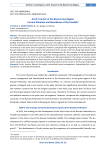
Arctic tourism in the Barents Sea region: current situation and boundaries of the possible
Статья научная
The modern features and peculiarities of the organization of the Arctic tourism in the Russian Federation are considered. Over the past ten years, the geography of recreational nature management and international tourism in the Russian Arctic has significantly expanded. Among the northern countries, Russia has the longest coastline in the Arctic seas and the largest sector of the adjacent shelf and waters of the seas of the Arctic Ocean. So its economic and political interests in the polar zone are obvious. However, compared with neighboring Arctic countries, in the Russian Federation for several reasons the potential of Arctic tourism is far from being fully utilized, and its further development is regulated by natural and anthropogenic factors. On the example of the actively developing Arctic cruise tourism in the Barents Sea region, the existing problems and prospects of the possible development of tourism in the Arctic in modern conditions are discussed. Based on the studies characterizing the modern development of Arctic tourism in general and in the Barents Sea basin in particular, the author made generalizing conclusions, which list the factors limiting the development of Arctic tourism in the Russian Federation.
Бесплатно
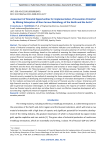
Статья научная
The analysis of methods for assessing the financial opportunities for increasing the economic efficiency of industrial enterprises using absolute and relative indicators and coefficients was carried out. A mechanism for determining financial possibilities for realizing innovative potential of northern mining enterprises of non-ferrous metallurgy, based on the method of assessing the three-component coefficient, which allows choosing the most rational strategy of scientific and technological development, taking into account financial resources and features of production functioning in the northern regions of the Russian Federation, was developed. It is shown that the proposed methodology can be used with limited information in the accounting statements provided in public access. On the basis of objective indicators, the research of innovation activity of twenty industrial enterprises of non-ferrous metallurgy directly operating in the North and the Arctic and included as subsidiaries and branches of seven largest corporations — PJSC MMC “Norilsk Nickel”, JSC “Mine Karalveem”, PJSC “Acron”, JSC “Mining company “Berelekh”, PJSC “Seligdar”, OJSC “Susumanzoloto”, JSC “Polymetal” for the period 2013–2019 was carried out. Studies showed the dependence of the innovation activity of northern enterprises of non-ferrous metallurgy on the level of financial security revealed by the method of assessing the three-component coefficient. Scientifically substantiated possibility of developing and implementing a strategy of innovation development of enterprises for the medium and long term periods based on the level of financial security is shown. Enterprises with high financial security or in special cases (with additional investments with normal financial security) are able to generate innovation technologies. As the analysis has shown, the majority of northern enterprises have low financial security, which does not allow them to count on effective innovative development without attracting a significant amount of targeted investments.
Бесплатно
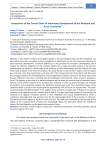
Assessment of the Current State of Innovative Development of the Northern and Arctic Territories
Статья научная
In the modern realities of the global change in the technological order and the emergence of a post-industrial society, innovative activity strengthens its significance as the most important resource for socio-economic development. Territorial differences in the potential for innovative development, which impede the effective integration of the northern regions into a single innovation system of the country, predetermine the need for a deep study of the problems of their development and the study of the main factors and prospects in the field of innovation. The study focuses on the northern regions of the European part of Russia, since they concentrate more than half of the human potential of the North and determine the strategic prospects for the development and strengthening of national security in the Arctic zone of the Russian Federation in the face of existing risks and challenges: environmental, social, economic and geopolitical. The purpose of this work is to identify prospects and to assess the current state of innovative development of the northern regions of the European part of Russia. In order to achieve the goal, the methods of statistical and comparative analysis, the dialectical method were used. The informational basis of the study was made up of data from Rosstat and the departmental civil service at the regional level. The analysis demonstrates the differentiation of the regions of the northern European part of Russia at the level of innovation and regional economic systems that include it. The most important prospect of overcoming the weaknesses of regional innovation systems is their integration and mutual complementarity, which is sometimes achievable with new systemic tools for the spatial organization of the economy, in particular, the special economic regime of the Arctic zone of Russia. The study was conducted on the example of five regions of the European North of Russia: the Arkhangelsk Oblast, the Murmansk Oblast, the Republic of Karelia, the Komi Republic and the Nenets Autonomous Okrug.
Бесплатно
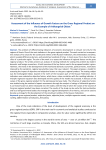
Статья научная
The problem of differentiating indicators of economic development is relevant not only for the regions of Russia. One of the main indicators is the gross regional product. The work carried out a comparative analysis of its values for the constituent entities of the Russian Federation, the United States and China, which revealed differences by tens, and sometimes hundreds of times. In most cases, this is due to the specifics of a particular region. The aim of the work is to assess the influence of regional factors on the gross regional product. The article presents an analysis of existing methods for solving this problem by modern domestic and foreign researchers. A brief overview of the key factors used in the proposed models is given. However, the trends in the development of the world and domestic economies, political events, restrictions imposed by the pandemic, regional peculiarities leave this issue relevant. The paper proposes a model for assessing the impact of objective and subjective factors on the gross regional product. The testing subject was the Arkhangelsk Oblast, located in the north of the European part of the Russian Federation. Seven indicators were selected as objective factors, which have a close correlation with the resulting indicator. A multiple regression equation was developed and the quality of the model was assessed. A forecast of the values of the gross regional product for the planning period was made. The influence of subjective factors was studied using the method of expert assessments through the analysis of ratings of influential agencies. A correction factor has been introduced into the model, with the help of which the values of the volume of the gross regional product have been corrected. The results of the study can be useful for state authorities and local self-government bodies that manage the regional development of territories, and can be used to develop a strategy for the development of the constituent entities of the Russian Federation.
Бесплатно
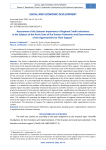
Статья научная
The article is devoted to the analysis of the banking sector in the Arctic regions of the Russian Federation, the identification of systemically significant regional credit organizations in the subjects of the Arctic zone of the Russian Federation and the study of possible areas of their support. The dynamics of existing credit organizations and their subdivisions in the Arctic zone of the Russian Federation in 2020-2021 is considered. It is determined that there are five regional credit organizations operating in nine Arctic regions now, of which one is a private non-banking one. Their activities are mainly aimed at the development of the real sector of the economy of the home region, at lending to small and medium-sized businesses. The detailed characteristics of the regional banks registered in the Arctic regions and the indicators of their activity are given. It is concluded that the allocation of significant banking structures for the functioning of regional economic systems and their support is an important issue in the analysis of the modern banking system. It is noted that the problem of developing criteria for identifying systemically significant banks for specific regions has been repeatedly raised and discussed in scientific research. It is concluded that for the practical assessment of the systemic significance of regional banks, modification and refinement of currently existing methods are required. The article offers the author's methodology for calculating the indicators used in assessing the systemic significance of a regional credit institution for a subject of the Russian Federation. The indicators of assessing the degree of systemic significance of regional commercial banks registered in the regions of the Arctic zone of the Russian Federation are calculated, and their score assessment is performed. The directions of support for regional systemically important credit organizations are presented.
Бесплатно
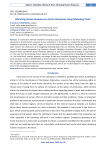
Attracting human resources to arctic enterprises using marketing tools
Статья научная
In connection with the movement of various types of production in the Arctic region, it becomes necessary to attract human resources to new enterprises. In the article, we analyze the branding system in companies operating in the Arctic region, as one of the most effective areas in marketing activities in the labor market. The study aims at investigating marketing tools that can eliminate the lack of qualified personnel in well-known companies, e.g., Rosatom, Rosneft, PhosAgro, Eurochem, Novatek, Lukoil, Severstal, Gazprom Neft, and Norilsk Nickel. Particular attention is paid to analyzing the branding of organizations, i.e., the main tool for attracting human capital to enterprises. The components of branding are considered, i.e., the brand itself, mission, purpose, and image. A table was compiled illustrating the listed elements for each company. It takes a detailed look at which companies should try to change branding elements to attract more attention from job seekers. The study of the key concepts of branding helped to draw appropriate conclusions about the need to reform marketing tools, which are not developed to one degree or another in the investigated companies.
Бесплатно

Best Practices of Oil and Gas Companies to Develop Gas Fields on the Arctic Shelf
Статья научная
The development of the hydrocarbon potential of the Arctic shelf is one of the priority tasks for Russia, forming the conditions for its strategic presence in the region. Russia's official energy documents stipulate the need to increase oil and gas production in the Arctic, including offshore production, to ensure the stable operation of the country's oil and gas complex in the long term. However, the development of hydrocarbon fields on the Arctic shelf is a serious technological challenge for the domestic oil and gas industry. While offshore oil production in the Russian Arctic is already underway, natural gas production remains a promising future target. The article analyses the current gas projects on the Arctic shelf in terms of their technological complexity and unique solutions, and the strategies of operators to attract foreign participants to the project. We consider these in the contexts of technological issues, organizational features, securing foreign investment. The author believes that the provisions and conclusions of this study will help add to the comprehensive picture of the foreign oil and gas companies experience engaged in natural gas production on the Arctic shelf, which will minimise the errors and risks in the development of hydrocarbon resources on the Russian Arctic seas shelf.
Бесплатно
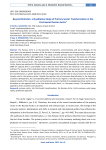
Статья научная
The Russian Arctic is at the epicentre of economic, environmental, and social changes. At the same time, the peripheral character of the territory, its strong orientation on primary sector makes the region extremely volatile to suchlike shifts. The study concerns primary sector transformation in the Post-Soviet period when after 1991 significant changes in the economy were observed. The main aim of the paper is to identify the specifics, features and development prospects of the recent primary sector transformation in the Russian Arctic. The statistical methods do not reflect the full picture of the transformation. Firstly, Russia has switched to UN national accounts system only in 1994. Secondly, the Arctic statistics after 2009 for regional level is unavailable. That is why the main method of the research is the expert survey method. The results of the study demonstrate the dominant role of the primary sector and the strong dependence of Russian Arctic regions on these activities. The study identifies the key factors and drivers of the transformation, a specific position of the oil and gas sector and the role of natural resources to be traditionally used in the primary sector. Despite the positive role of economic diversification in the long-term economic development, the corresponding effect for the Arctic regions is not fully expressed. The methodological novelty of the research is an unconventional research method of investigating primary sector transformation on the regional level in the Post-Soviet Russian Arctic, i.e. the expert survey. The method can be applied to other countries and industries.
Бесплатно

Business and government: environmental and economic responsibility in the Russian Arctic
Статья научная
The growing interest in environmental problems on the part of society leads to the fact that more and more attention is paid to the activities of enterprises, and the criteria for the greening of their production are becoming more stringent. With the growth of industrial production, the scale of the negative impact on the environment increases, so simply discussing environmental problems becomes insufficient. There is a need for a comprehensive accounting of the environmental performance of organizations and the development of measures to compensate for the resulting environmental damage. The article examines the issues of environmental and economic relations between business and government in the Russian Arctic. The purpose of this study is to form a theoretical approach to solving the problem of greening the Arctic regions based on the analysis of the ecological and economic relations between government and business. Legal and economic instruments for regulating environmental protection in Russia, as well as strategic documents for the development of the Russian Arctic in the field of ecology are analyzed. An assessment of the environmental and economic responsibility of companies operating in the Russian Arctic is carried out on the basis of non-financial reporting data. The results of the analysis show that the presented non-financial information is not transparent enough, and the level of business responsibility is rather low. To solve the problem posed, the authors propose a theoretical approach to building a "green" partnership, which allows finding a compromise between the interests of the state and business. The formation of an integrated ecological and economic approach in the state regulation of environmental protection activities will allow reaching a point of bifurcation in the relationship between government and business and thereby leveling the anthropogenic load on the ecosystem of the territory.
Бесплатно

Статья научная
The article analyzes the managerial innovation of the Russian government on a new type of territorial management of the Arctic macroregion - support zones of development. The authors present an overview of the mineral deposits developed and planned for development within the boundaries of the Kola Peninsula and investment projects of the largest mining companies of the Murmansk region and, above all, the project “Kola Chemical and Technological Cluster” in accordance with the requirements developed by the federal regulator for forming mineral resource centers in support zones of development in the Arctic Particular attention is paid to the deposits of strategic and scarce minerals attractive for private investors. They will not require significant expenditures from regional authorities and local selfgovernments for development activities or any other methods of the state support and are socially significant for the region. The authors also discuss methodical approaches to management decisions when selecting the most efficient projects for implementing, the goals of socio-economic development and ensuring the ecological safety in the Arctic region under the global climate changes. Basing on the draft federal law “On the Arctic zone of the Russian Federation”, it was concluded that the mineral resource center of the Murmansk region was not likely to be included in the pilot project in 2018-2020 to form the Kola support zone of development in the Arctic. Proposals on harmonizing the requirements for registering applications of the Russian Arctic regions for forming the mineral resource center of the Kola support zone with the order on inclusion of mineral reserves in the state balance list. The authors justified methodology for developing investment projects and the procedures for their state comprehensive and environmental assessments. Some proposals for enhancing the efficiency of activities of applicants and participants in the support zone are made.
Бесплатно

Статья научная
The uniqueness of today's social processes triggered by the COVID-19 pandemic determines the lack of insights into the transformation of the socio-economic space of the Russian Arctic. The purpose of this article is to review the past, recent, and future conditions for development and management of the Russian Arctic, considered in the context of the unfolding crisis of a non–economic nature and its consequences. The methodological peculiarity of the review is presentation of the phenomenon of the current crisis in the context of interrelated fundamental problems of the development of the Russian Arctic, the new economic reality, which makes it difficult to reliably predict the future. This naturally led to the substantiation of a series of contradictions and difficulties in implementing the declared development goals of the Russian Arctic, that are specifically reflected in the title of the article — "chimeras", which in biology means an organism consisting of genetically heterogeneous cells. A statistical description of the specifics of socio-economic development of the Arctic regions under the COVID-19 pandemic has been carried out in the context of review of the support measures, examination of the economic structure and the corresponding scale of "disconnection" of the regions' economies during the period of isolation and the subsequent recovery. It is revealed that the Arctic regions demonstrate greater economic resilience compared to the overall Russian situation, which is associated not so much with the strengthening of stabilization measures at the federal level with the support of the regional level, but with the fundamental reasons — the relative simplicity of the Arctic extractive economy, higher population incomes, low level of small and medium business development. Navigation on the risks and opportunities of governing the Russian Arctic has been carried out, linking the fundamentals and the practical implications of the study through the traditional rationale for navigating and considering the practice of managing an object, in our case, the Arctic, as well as routing, which is, choosing the path to follow. In particular, it makes a strong case that the pandemic has deepened the problems and risks that are also major management targets for the "precursor" period and creates a new hypothetical risk — the diminishing scale of the Arctic's social and economic development goals, including practices for securing conditions for increased standards of living and quality of life for its people.
Бесплатно
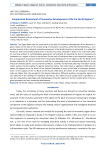
Comparative assessment of innovative development of the Far North regions
Статья научная
The paper deals with the assessment of the level of innovative development of the Northern regions. Based on the data of the annual rating of innovative economies, performed by Bloomberg, a comparative analysis of the rating of innovative economies in the Nordic countries is presented. It is noted that Russia has been consistently ranked 25-27 in the last four years, although in 2016, it was in the 12th place. An overview analysis of methodological approaches and methods for assessing the level of innovative development of a region in Russia is carried out. On the basis of statistical data on the composite integral index, a comparative assessment of the level of innovative development of 17 regions of the Far North of the Russian Federation for 2017 is carried out, and the corresponding ranks are analyzed separately for 5 sub-indices of thematic blocks: socio-economic conditions, scientific and technical potential, innovation activity, export activity and the quality of regional innovation policy. The study shows a significant difference between the regions of the Far North of the Russian Federation in terms of the level of innovative development. In five subjects of the Far North of the Russian Federation, the values of the composite innovation index are higher than the average for the Russian Federation. Different positions occupied by regions are also observed in the rankings for individual sub-indices. The results of such ratings make it possible to assess the comparative advantages and disadvantages of specific regions for further consideration in the program documents on their innovative development.
Бесплатно
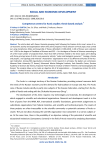
Competence centers for Arctic studies: thesis-based analysis
Статья научная
The article deals with theses thematic grouping, both following the Russian Arctic zone’s areas of socio-economic activity and organizations where they were prepared. Thesis selection on Arctic topics was carried out using morphemes (titles and keywords) of theses defended in 1990-2018. 1.436 of theses were selected, incl. 1.201 for the degree of Candidate of Sciences and 235 - for the degree of Doctor of Sciences amounting to 1% of the total number of analyzed theses. More than 50% of theses related to the Arctic topics were dealing with three principal areas of Arctic socio-economic activity: “water and biological resources”, “ecology, climate and people”, and “geology and minerals”. Researchers’ organizations were located in 51 different territories of the Russian Federation. Among 503 organizations involved in Arctic research on all topics, the leaders are Lomonosov Moscow State University (72 theses), Murmansk Marine Biological Institute, Kola Scientific Center, Russian Academy of Sciences (62 theses), Knipovich Polar Research Institute of Marine Fisheries and Oceanography (43 theses). The analysis allows us to create an objective list of all organizations - Competence centers for Arctic studies - involved in areas related to Arctic socio-economic activity.
Бесплатно
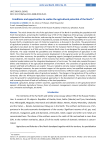
Conditions and opportunities to realize the agricultural potential of the North
Статья научная
The article shows the role of the agricultural sector of the North in providing the population with fresh food products, preserving the traditional way of life of the indigenous ethnic groups, sustainable de-velopment of the northern territories, and ensuring the country's food security. The organization of agriculture in the north and Arctic territories of Scandinavia, Canada and Alaska and the possibility of its use in the Russian North, considering its own rich historical experience, is discussed in the article. The generalization of agricultural practices in northern countries allows us to recommend the Scandinavian development of agriculture and, above all, the experience of Finland for the European North of Russia. Canadian model of agricultural development is of little use for the Russian North since it was designed for sparsely populated territories. The study revealed the possibilities and limitations of the development of agriculture in the North. The critical points for the socio-economic development in the agrarian sector are the availability of natural and labor resources, the possibility of organizing organic (ecological) production within the traditional industries, the industrial nature of the economy that directs significant financial resources for the industrial modernization and the integrated development of rural areas. The study also revealed the possibilities and limitations of the agricultural development of the North. The constraints of agricultural development and food self-sufficiency are explicit. They are related to extreme natural conditions, low availability of biological resources, the poor technical support of the agrarian sector, low-qualified employees and hard living conditions of peasants, unfavorable external environment, inefficient state support, unavailability of loans, and unsustainable sales of agricultural products. The changes in the agriculture of the northern territories after the All-Russian Agricultural Censuses 2006 and 2016 revealed. The results of the study serve the ground for substantiating conceptual approaches to the development of agricultural production and increasing the level of food self-sufficiency of the local population.
Бесплатно

Critical tendencies of the transport infrastructure development in the Russian Arctic
Статья научная
In the article, the authors discussed the formation of a single transport system in the Arctic zone of the Russian Federation. The development of the Arctic transport system, i.e., the Northern Sea Route, adjacent airport network, seaports, water, and land communications, determined the relevance and significance of the study. It is especially important since they are the strategic priorities of Russia's Arctic policy. The study aimed to identify the trends in transport infrastructure development in the Russian Arctic. So, the authors focused on the factors determining its specifics. They conclude that the transport infrastructure of the Arctic zone of the Russian Federation is underdeveloped and needs technical improvement. According to the authors, a unified Arctic transport system is possible only after the restoration of year-round navigation through the NSR, its technological growth, and the reconstruction of the adjoining transport infrastructure.
Бесплатно

Статья научная
The northern regions of Norway and Russia have similar issues: new mega-projects for the development of oil and gas fields and infrastructure are not only an opportunity but also a challenge for the de-velopment of regional small and medium-size enterprises. To connect to projects, regional enterprises need to increase their competencies and find opportunities for cooperation with each other. The article presents the results of a study of the formation of a regional business alliance in Northern Norway. Further, it offers an analysis of the possibility of applying the North Norwegian experience to Russia. It is concluded that, although from a theoretical point of view, this is difficult, the prerequisites for the successful application of the studied experience exist in the Arkhangelsk Oblast and the Murmansk Oblast. Two business associations are successfully operating there. They were built considering the Norwegian experience, but with the active participation of local industry and authorities, as well as accounting regional specifics, values, and traditions. It is a powerful foundation for the further development of business cooperation. The article contains several recommendations for such forms of collaboration. It is proposed to pay attention to the following: qualification of the coordinator, public-private financing scheme, openness and integration of the project, primary importance of technological cooperation idea and secondary significance of the legal form to be chosen.
Бесплатно

Development of the North 2.0: challenges of making a new theory
Статья научная
It is proposed to create a new theory of economic development of the North on three primary sources — the Soviet development school, the European school of regional studies, the North American school of frontier studies. Each of these schools relies on a broad conceptual foundation (location of productive forces, endogenous economic growth, innovative search), the fusion of which is capable of radically and positively transforming the theory of modern time. Comparison of the nature of the development process today and in the Soviet times reveals significant differences: an increase in spatial and temporal irregularity (polarization), multiactorism, glocalization, and the role of the grassroots “design” level. Numerous projects of new development implemented in the Russian Arctic and the North have common features in the form of an experimental nature, pilot-clone schemes for saving on experience, a plurality of equal status supply and training bases, etc. Large resource corporations that lead the world are directing actors of the territorial structure of the process of new development, and it depends on the internal organizational and institutional structure of the company itself.
Бесплатно

